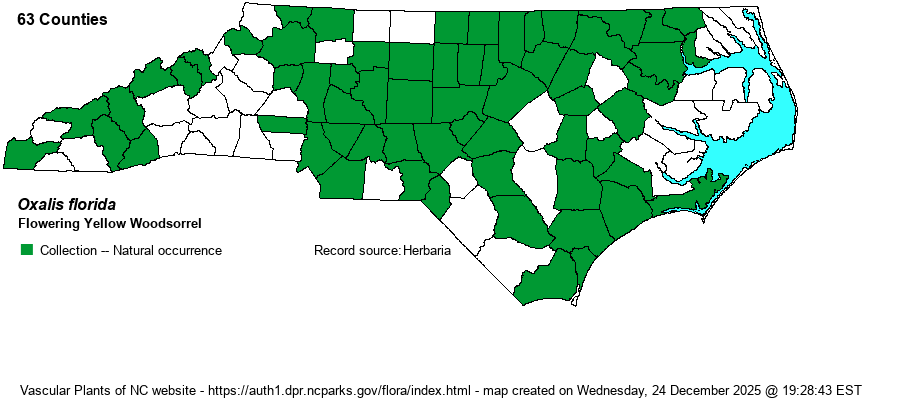| Section 6 » Family Oxalidaceae |
Show/Hide Synonym
| taxonName | relationship | relatedTaxonName | relatedTaxonRefText | relComments |
|---|
|
|
| Oxalis florida | = | Oxalis priceae ssp. colorea | Kartesz (1999) | | | Oxalis florida | = | Oxalis priceae ssp. colorea | Cocucci in Kubitzki (2004). Taxonomy and key based in part on Nesom (2009b) and Horne, Barger, & Nesom (2013). | | | Oxalis florida | = | Oxalis priceae ssp. colorea | Cocucci in Kubitzki (2004). Taxonomy and key based in part on Nesom (2009b) and Horne, Barger, & Nesom (2013). | | | Oxalis florida | = | Oxalis recurva var. recurva | Fernald (1950) | | | Oxalis florida | < | Oxalis recurva | Gleason (1952) | | | Oxalis florida | = | Oxalis florida var. recurva | Radford, Ahles, and Bell (1968) | | | Oxalis florida | = | Oxalis macrantha | Gleason and Cronquist (1991) | | | Oxalis florida | > | Xanthoxalis colorea | Small (1933, 1938) | | | Oxalis florida | > | Xanthoxalis recurva | Small (1933, 1938) | | | Oxalis florida | > | Oxalis filipes | Fernald (1950) | | | Oxalis florida | > | Xanthoxalis filipes | Small (1933, 1938) | | | Oxalis florida | > | Oxalis dillenii ssp. filipes | Cocucci in Kubitzki (2004). Taxonomy and key based in part on Nesom (2009b) and Horne, Barger, & Nesom (2013). | | | Oxalis florida | > | Oxalis dillenii ssp. filipes | Wofford (1989) | | | Oxalis florida | > | Oxalis dillenii ssp. filipes | Cocucci in Kubitzki (2004). Taxonomy and key based in part on Nesom (2009b) and Horne, Barger, & Nesom (2013). | | | Oxalis florida | > | Oxalis dillenii ssp. filipes | Cocucci in Kubitzki (2004). Taxonomy and key based in part on Nesom (2009b) and Horne, Barger, & Nesom (2013). | | | Oxalis florida | < | Oxalis dillenii | | | | Oxalis florida | < | Oxalis corniculata | Wunderlin & Hansen Flora of Florida (3) | | | Source: Weakley's Flora |
|
| Author | Salisbury | |
| Distribution | Present over nearly all of the state, though primarily found in the Piedmont and western 2/3rds of the Coastal Plain. Scattered over the Mountains and Piedmont foothills, and seemingly absent in the eastern counties.
This species ranges from VT and CT south to FL and LA. Note that BONAP does not show this species on its maps, it being lumped with O. dillenii. | |
| Abundance | Fairly common to common in the eastern and central Piedmont. Fairly common, at least locally, in most of the Coastal Plain. Uncommon in the Mountains and western Piedmont, and essentially absent in the far eastern counties. Confusion with O. dillenii makes it somewhat difficult to be certain of abundance patterns, but this species is scarce in the Mountains as compared with farther eastward. | |
| Habitat | This is mostly a forest species, growing in bottomlands and fairly moist upland hardwood forests, including on bluffs. It can be found in damp meadows or other reasonably sunny sites, but it is not weedy and generally is not found in ruderal field sites. | |
| Phenology | Blooms mainly from March to June, and rarely later; fruits soon after flowering. | |
| Identification | The many species of yellow-flowered Oxalis are quite similar to each other, with small details separating most. All are small, branched, with numerous 3-parted, clover-like leaves on long petioles, and inflorescences of bright yellow, 5-petaled flowers. This species has more slender stems that O. dillenii, its main source of confusion. Also, it is normally not as strongly strigose pubescent on the stem as is O. dillenii, and most obvious, if visible, is that it has a capsule that is glabrous or only sparsely with hairs, as opposed to the densely pubescent capsules seen in O. dillenii. O. stricta is similar, but that species (as well as does O. dillenii) grows in ruderal habitats, has a longer stem (about 1 foot tall or longer as opposed to only 4-6 inches tall), and has flowers in cymes rather than in umbels. Most people will be confused by the identification of yellow-flowered woodsorrels, but this species is the primary one found in forest interiors in the Piedmont and Coastal Plain, often as a spring ephemeral species on rich to mesic slopes. | |
| Taxonomic Comments | Confusing. BONAP and some other references do not even tease the species out from O. dillenii, and others may have had it lumped into O. stricta. Also, O. florida var. recurva, as listed in RAB (1968), has now been pulled out as a good species -- O. colorea.
| |
| Other Common Name(s) | Slender Yellow Woodsorrel (the common name here used for O. dillenii) | |
| State Rank | S4? [S5] | |
| Global Rank | G3G5 | |
| State Status | | |
| US Status | | |
| USACE-agcp | | |
| USACE-emp | | |

